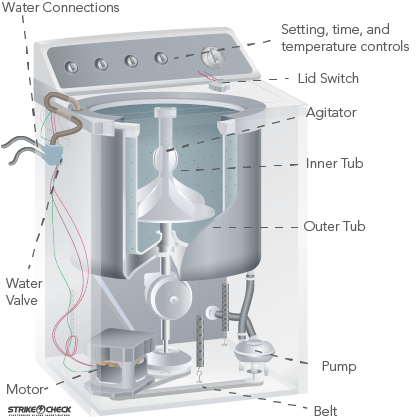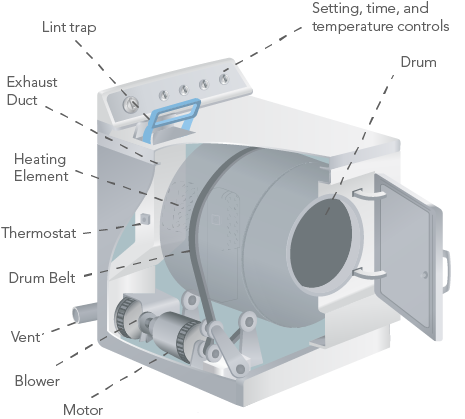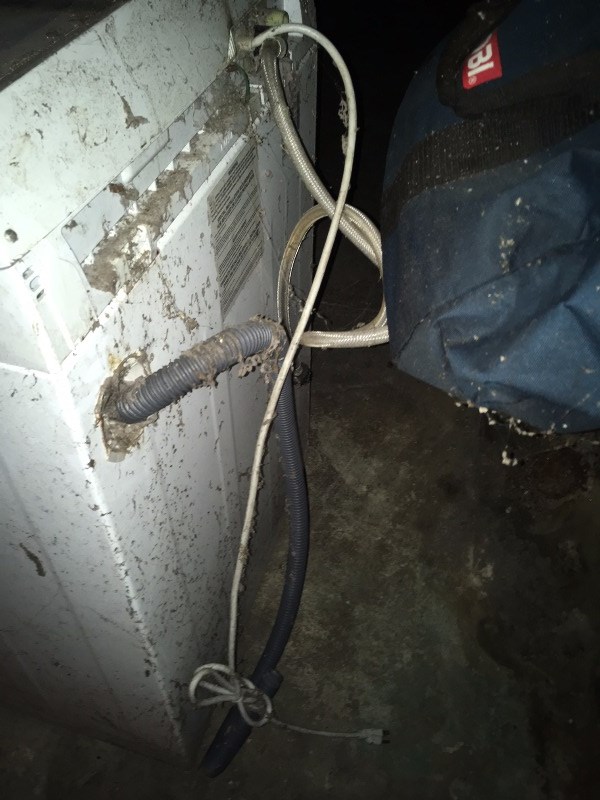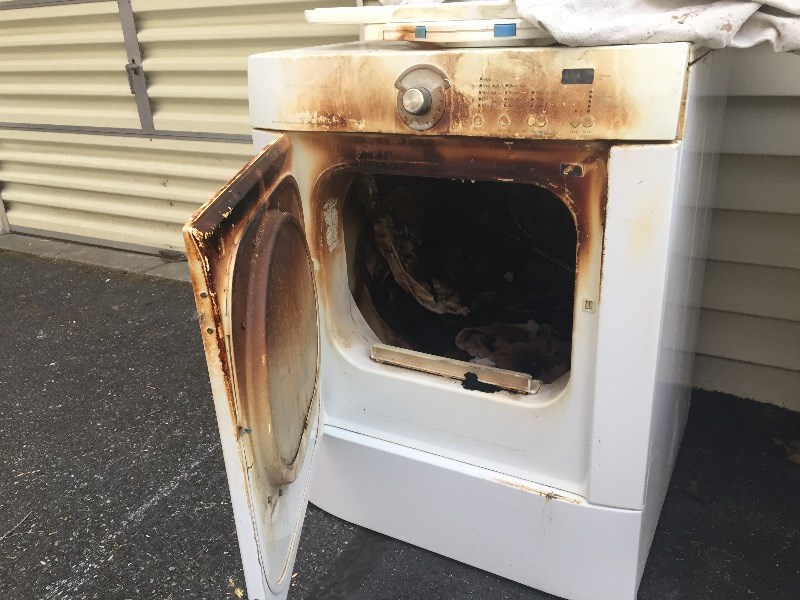Washer and Dryer Claims 101
Washer and dryer damage claims are often difficult due to their complexity of operation and the myriad of components that they contain. According to the US Census Bureau, over 85% of homes in the United States have a washing machine. The sheer prevalence of the equipment combined with their complexity can add up to a headache for property adjusters nationwide.
Get your free adjuster guide to washer and dryer claims
Because many components in both washers and dryers require regular maintenance, there are many opportunities for these appliances to fail. It can be difficult for even a seasoned adjuster to determine what caused the machine to fail and whether or not it can be repaired. Moreover, a damaged washer or dryer can cause additional property damage upon failure. By having a basic understanding of the different types of washers and dryers, how they work, and why they fail, adjusters can handle claims involving this type of damage easier and with a higher degree of confidence.
Washing Machines
Traditional Top-Loading Washing Machines
The most common type of washer is the top-load, belt-driven washing machine. This variety of washing machine uses an agitator to spin the clothes through the water and remove dirt. Agitator washing machines are the least expensive to purchase; however, they require the most water to operate, increasing the cost of utilities. These washers typically have the shortest wash time, but do not extract as much water as their high efficiency counterparts; resulting in an increased amount of time required for drying.
Top-Loading Agitator Washing Machine
Notably, agitator-style washing machines require less maintenance than high efficiency washers and subsequently tend to last longer than high efficiency washers (Consumer Affairs). Traditional agitator washing machines range from $300 to $900, depending on brand, features, and capacity.
High Efficiency Top-Loading Washing Machines
High efficiency top-load washers use an impeller motion and spin faster than traditional agitating machines. They clean clothes better, using less water, and extract water better than standard agitating washing machines, thereby reducing required drying time. A high efficiency washer takes longer to complete a cycle than the agitator variety, but is typically more gentle on clothes.
High efficiency top-load models are more expensive than agitator machines, but less expensive than front-load washers. These models typically range from $650-$1000 (Consumer Reports). High efficiency models require more maintenance than the traditional agitator variety and have a shorter lifespan, averaging around 11 years (The Spruce).
High Efficiency Front-Load Washing Machines
High efficiency front-load washing machines have the highest cleaning abilities and use the least amount of water of the three washer varieties, offering the greatest utility savings. These washers spin the fastest, which leads to a significant reduction on drying time. They are also the most gentle on clothes.
Front-load machines, however, are the most expensive of the three washing machine types, typically ranging from $1,000-$1,500 (Consumer Reports). Additionally, front-loading machines require the most maintenance and can develop mold more quickly than top-loading washers.
Dryers
Electric Dryers
The most common variety of dryer is the electric version. These dryers utilize electric heating coils that heat the air, which is blown through the clothes as they tumble. The heated water changes to steam and is vented out of the appliance and ultimately out of the home. A typical electric dryer utilizes a belt and a motor to rotate the drum, which tumbles the clothes through the heated air.
A Typical Electric Dryer
Electric dryers are less expensive than their gas counterparts to both purchase and install, but typically cost more to operate from a utility perspective. The cost of electric dryers varies greatly, ranging from $300-$1,500 depending on features, capacity, and brand. Electric dryers typically require little maintenance and have a slightly longer lifespan than gas versions (SF Gate).
Gas Dryers
Gas dryers are less common than electric dryers, because they require a natural gas hookup and an external combustion gas exhaust vent. These dryers operate similarly to an electric dryer, except that they utilize gas to generate heat, which heats a series of metal plates, and is then transferred to the air to dry the clothes. Gas dryers in turn dry clothes more quickly and are more efficient than electric varieties, and are generally less expensive to operate over time.
Gas dryers are more expensive to purchase and install. Gas dryer purchase prices range from roughly $400-$1,800 depending on the brand, features, and capacity of the dryer. Additionally, they should be installed by a professional, increasing the total cost of acquisition. The installation location will require a gas hookup and an exterior vent (this will need to be installed if not available), adding additional expense to the total price.
Additional Washer and Dryer Risks
Washer Flooding
Washing machine flooding can cause significant property damage. As one of the top-ten leading sources of residential water losses, water damage from washing machines is a frequent occurrence (IBHS). Moreover, the average flooded washing machine incident leads to over $5,000 in damages (Farmers Insurance). Most of these cases are caused by a failed water supply hose. With age, the water supply hose can crack, deteriorate, or become loose. To reduce this risk, hoses should be checked monthly and replaced every three to five years. Other common causes of washing machine flooding include overloading the appliance and not using a designated HE detergent in high efficiency machines (SF Gate).
A broken hose on the washing machine caused extensive water damage to the insured’s basement
An increasing factor to this risk is the failure of hoses in unoccupied homes. While unoccupied homes only account for roughly 6% of washing machine failures, the damages from these cases are nearly two and a half times more severe than those that occur in occupied homes (IBHS). It is important for property owners to ensure that, at a minimum, hoses to the washing machine have been shut off, if the property is expected to remain vacant for an extended period of time.
Dryer Fires
On average, residential fires caused by a dryer occur nearly 3,000 times per year and causes an estimated $35 million in property damages (FEMA). The leading cause of dryer fires is failure to clean out the lint trap or vent (NFPA). If these are not properly maintained, it can block the flow of air and cause the dryer to overheat. Other leading causes of fire include overloading the dryer, drying items that contain foam, rubber, or plastic, leaving the dryer running when no one is home, and drying items that have been exposed to flammable substances, such as alcohol, oil, or gasoline.
A fire started inside of the insured’s dryer, causing significant damage to the home
The risk of a dryer fire can be greatly reduced by performing regular maintenance on the appliance. In addition to simply cleaning the lint filter after every load, the vent should be cleaned every three months to ensure that airflow is not being restricted. The risk of fire can also be reduced by replacing plastic or foil ducts with rigid ducts, as the plastic and foil variety can trap lint or become kinked and reduce airflow. Additionally, gas dryers should be inspected by a professional annually to ensure that the connections are tight, and there are no leaks.
It is critical that adjusters are able to handle washer and dryer claims accurately. These claims occur frequently and determining the cause of loss and viable repair options is vital, not only to reducing indemnity exposure, but also in reducing the risk of water damage and fire.
Moreover, it is crucial that property owners properly maintain the onsite washer and dryer, as the consequences can be grave. Insurance professionals should warn their clients of these risks, as many are associated with lack of maintenance and can create a hefty financial burden if not covered by the insurance policy.




